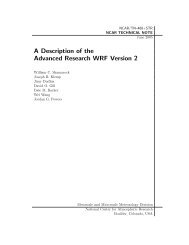You also want an ePaper? Increase the reach of your titles
YUMPU automatically turns print PDFs into web optimized ePapers that Google loves.
INITIALIZATION<br />
Making modifications apart from namelist-controlled options or soundings has to be done<br />
by editing the Fortran code. Such modifications would include changing the topography,<br />
the distribution of vertical levels, the properties of an initialization thermal bubble, or<br />
preparing a case to use more physics, such as a land-surface model. The Fortran code to<br />
edit is contained in ./<strong>WRF</strong>V3/dyn_em/module_initialize_[case].F, where<br />
[case] is the case chosen in compilation, e.g.<br />
module_initialize_squall2d_x.F. The subroutine to modify is<br />
init_domain_rk. To change the vertical levels, only the 1-D array znw must be<br />
defined, containing the full levels starting from 1 at k=1 and ending with 0 at k=kde. To<br />
change the topography, only the 2-D array ht must be defined, making sure it is periodic<br />
if those boundary conditions are used. To change the thermal perturbation bubble, search<br />
for the string "bubble" to locate the code to change.<br />
Each of the ideal cases provides an excellent set of default examples to the user. The<br />
method to specify a thermal bubble is given in the super cell case. In the hill2d case, the<br />
topography is accounted for properly in setting up the initial 3-D arrays, so that example<br />
should be followed for any topography cases. A symmetry example in the squall line<br />
cases tests that your indexing modifications are correct. Full physics options are<br />
demonstrated in the seabreeze2d_x case.<br />
Available Ideal Test Cases<br />
The available test cases are<br />
1. 2-D squall2d_x (test/em_squall2d_x)<br />
o 2D squall line (x,z) using Kessler microphysics and a fixed 300 m^2/s<br />
viscosity.<br />
o periodicity condition used in y so that 3D model produces 2D simulation.<br />
o v velocity should be zero and there should be no variation in y in the<br />
results.<br />
2. 2-D squall2d_y (test/em_squall2d_y)<br />
o Same as squall2d_x, except with (x) rotated to (y).<br />
o u velocity should be zero and there should be no variation in x in the<br />
results.<br />
3. 3-D quarter-circle shear supercell simulation (test/em_quarter_ss).<br />
o Left and right moving supercells are produced.<br />
o See the README.quarter_ss file in the test directory for more<br />
information.<br />
4. 2-D flow over a bell-shaped hill (x,z) (test/em_hill2d_x)<br />
o 10 km half-width, 2 km grid-length, 100 m high hill, 10 m/s flow,<br />
N=0.01/s, 30 km high domain, 80 levels, open radiative boundaries,<br />
absorbing upper boundary.<br />
o Case is in linear hydrostatic regime, so vertical tilted waves with ~6km<br />
vertical wavelength.<br />
5. 3-D baroclinic waves (test/em_b_wave)<br />
o Baroclinically unstable jet u(y,z) on an f-plane.<br />
<strong>WRF</strong>-<strong>ARW</strong> V3: User’s <strong>Guide</strong> 4-4

















